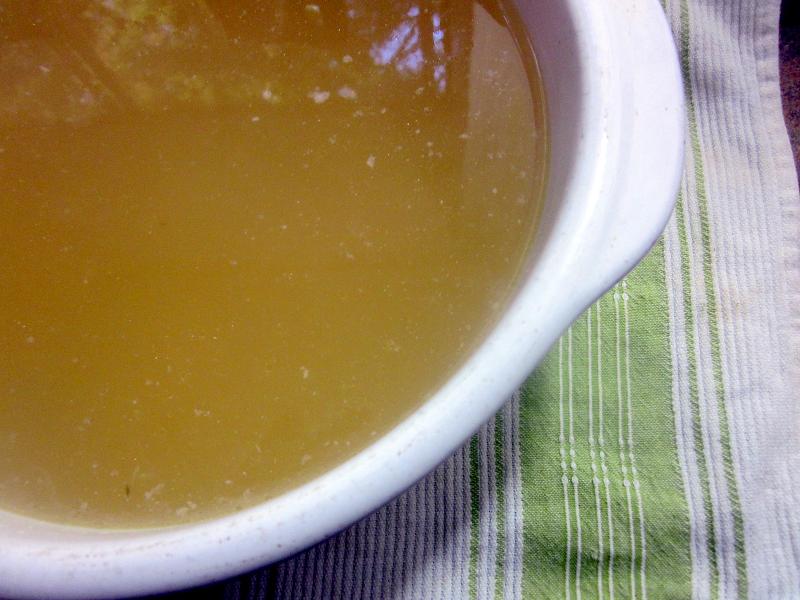 I returned home from work the night after Halloween to find a severed head in my fridge.
I returned home from work the night after Halloween to find a severed head in my fridge.
It was arranged on a plate next to the celery, eyes bulging, mouth agog with still-glistening tongue half protruding the way I’d imagine a strangulation victim’s would. It wasn’t a person’s head of course; it belonged to a fish, a really big fish… But it was still kind of a shock.
While I was at the restaurant, Crystal’s sister had stopped by with a present from the clan in Ucluelet. Uncle Chuck had landed a huge Halibut and (because he’s awesome!) shipped it over to us, packed in ice. Lisa had spent the afternoon processing the beast and once it was down to nothing but guts ‘n gills she figured I’d take care of the rest. She was absolutely right! It’s just the kind of weird stuff I love doing on a weekend.
So what do you do with a big dead fish’s head?
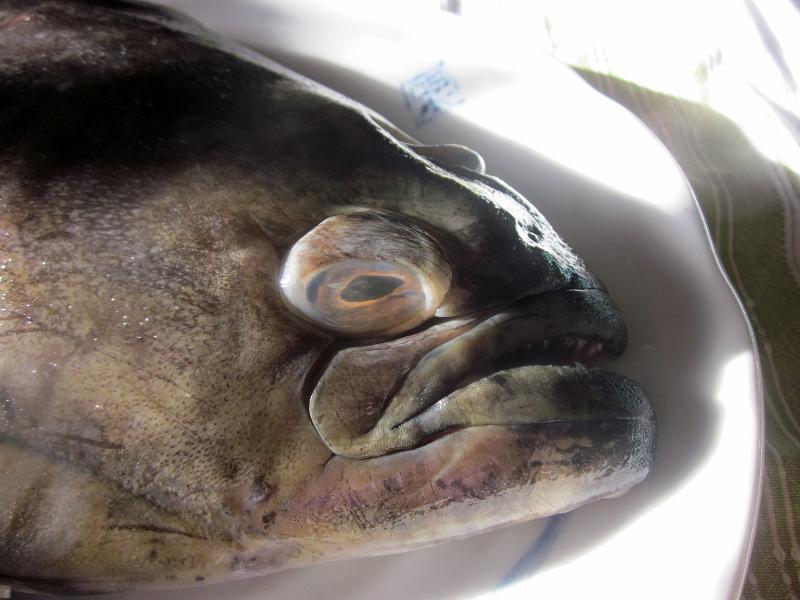 You don’t throw it away, that’s for sure! I’ve been part of a First Nations family and a Japanese kitchen crew for many years now and I’ve developed a respect for, and even love of the tough, rubbery and sometimes gelatinous pieces of fish that get tragically trashed. There is precious white flesh that can be extracted from the head, and the remaining bones, fins and face can be used for a flavourful yet delicate fish stock.
You don’t throw it away, that’s for sure! I’ve been part of a First Nations family and a Japanese kitchen crew for many years now and I’ve developed a respect for, and even love of the tough, rubbery and sometimes gelatinous pieces of fish that get tragically trashed. There is precious white flesh that can be extracted from the head, and the remaining bones, fins and face can be used for a flavourful yet delicate fish stock.
Processing A Halibut Head
The first step is to clean it. Halibut isn’t an overly-oily fish (which is why it’s so great for making stock) but it does have a slightly slimy skin texture that will endure on long after death. Empty a sink and scrub the head all over while you’re running the cold water. I like to use an old soft-bristled dish brush that is reserved for fish only. Just be careful around the eyes, they’re kind of delicate.
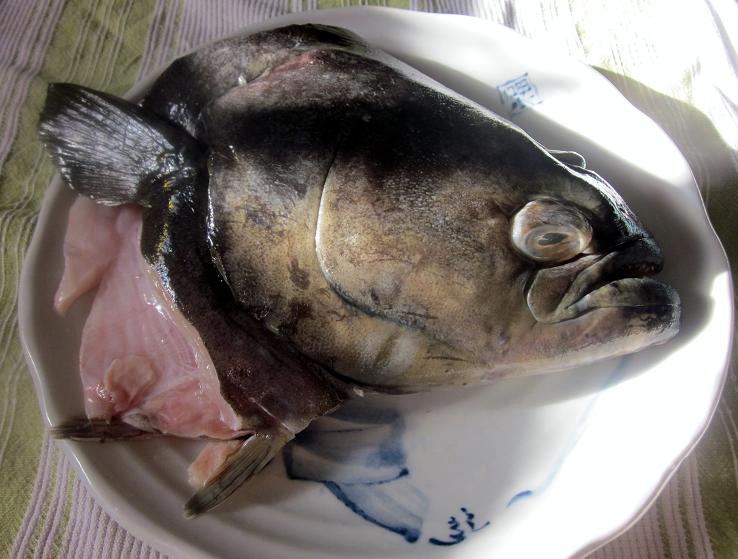 Pull out the gills and scrub inside the cavity that formerly held ‘em. These filthy filters are inedible and need to be tossed before they stain the rest of the head. Once they’re gone it becomes pretty easy to distinguish the “mantle” (the soft collar of meat that circles the outside of the hard gill plates) from the rest of the head.
Pull out the gills and scrub inside the cavity that formerly held ‘em. These filthy filters are inedible and need to be tossed before they stain the rest of the head. Once they’re gone it becomes pretty easy to distinguish the “mantle” (the soft collar of meat that circles the outside of the hard gill plates) from the rest of the head.
Remove the mantle by inserting a sharp knife into the center of the fish’s chin and sliding the knife along the edge of the gill plates until it reaches a point at the top of the head. Repeat the same cut on the other side of the head. At this point I suppose I ‘aught to address the whole “why the heck are there two eyes on one side of it’s face” thing… Well you see… Ahhh, forget it, look it up on Wikipedia. Just know that both side of the head are the same, just one (the darker side) has both eyes. Remove the mantle and insert your knife through either end to separate it into two parts. Set ‘em aside for later.
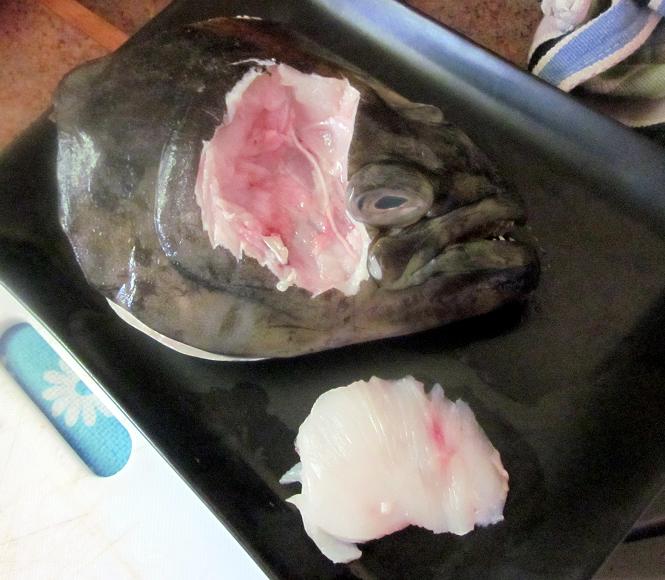 Next are the cheeks! Often cited as the best bits of meat on the whole fish, these two über-tender nubs can be carved out by digging your knife in just behind the eye (the one that looks like it’s in the right place) and run the tip along the jaw bone down to where it meets the edge of the gill plate. Scrape your knife up and around the whole of the plate then back to the eye.
Next are the cheeks! Often cited as the best bits of meat on the whole fish, these two über-tender nubs can be carved out by digging your knife in just behind the eye (the one that looks like it’s in the right place) and run the tip along the jaw bone down to where it meets the edge of the gill plate. Scrape your knife up and around the whole of the plate then back to the eye.
The meat lies in the shallow space in the center. Keep the knife tip pointed low and go nice and slow. The natural shape of the fish’s bones will show you where to cut. Repeat the same process on the other side of the head.
“The closer the bone, the sweeter the meat” goes the old saying, and there is a lot of meat to be found nestled between the boney plates of this cranium. First, go back to the mantle that you removed and dig out all that good stuff! The top nub is almost all edible and the sides are hiding little veins of flesh that can be scooped out and saved for chowder. Continue burrowing into the head behind the eyes and along the plates, anywhere that isn’t hard bone could be hiding something tasty. I was able to salvage almost a pound of meat from just that one head!
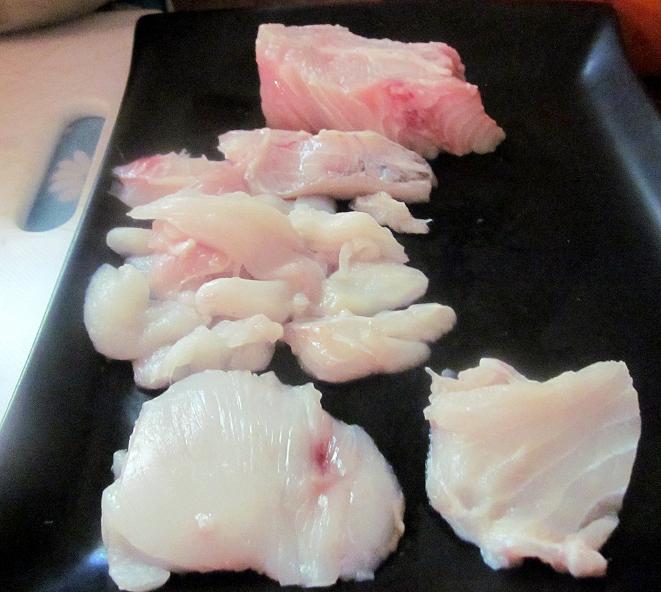 Wrap and refrigerate the meat for later and gather up the pieces of the mantle, the head, fins and any other stray bones. It’s time to brew some quality fish broth.
Wrap and refrigerate the meat for later and gather up the pieces of the mantle, the head, fins and any other stray bones. It’s time to brew some quality fish broth.
Fish Stock (Makes 2 Litres)
Ingredients
- 2.6 lbs. Halibut Head and Bones (1.2 Kg)
- 1 Tbls. Butter
- 1 Large Leek (250g white and green parts – washed and chopped)
- 1 Celery Stalk (75g, chopped)
- 2 Medium Fennel Stocks (75g, chopped)
- 2 Tbls. Parsley Stems (20g, left whole)
- 1 ½ Tbls. Dill Stems (14g, left whole)
- ½ Cup White Wine (I went with a Semillon-Chardonnay from Calona Vineyards)
- 2.6 Quarts of Cold Water (2.5 Litres)
- ½ Lemon
- 1 Bay Leaf
- Pinch of Whole Black Peppercorns
Method
- The classics teach us that blanching fish bones isn’t necessary for making a good stock. I believe that big nasty fish heads on the other hand need to be blanched just to be sure all the grit and slime have been removed. Grab a big stockpot, half-fill it with hot water and fire it up on high heat. Once it’s boiling, use a long handled spider or strainer to dunk the halibut head into the water for 1 minute then remove the head to a nearby bowl. Wash the head under cold running water, making special note of the back of the head – look for blood and grit from behind the eyes. Empty the stockpot and wash thoroughly.
- Return the pot to medium heat and melt the butter. Add the leeks, celery and fennel, cover and sweat the vegetables for 3 minutes (soft and translucent, not browned). Add the parsley and dill stems, cover and sweat another 1 minute. Pour in the white wine and bring it to a simmer. Cook uncovered for 2 minutes or until the wine has reduced by ½.
- Pour in the cold water and bring to a boil. Add the lemon, bay leaf, peppercorns and blanched fish head. Reduce heat immediately to med-low so that the stock can gently simmer for the next 40 minutes.
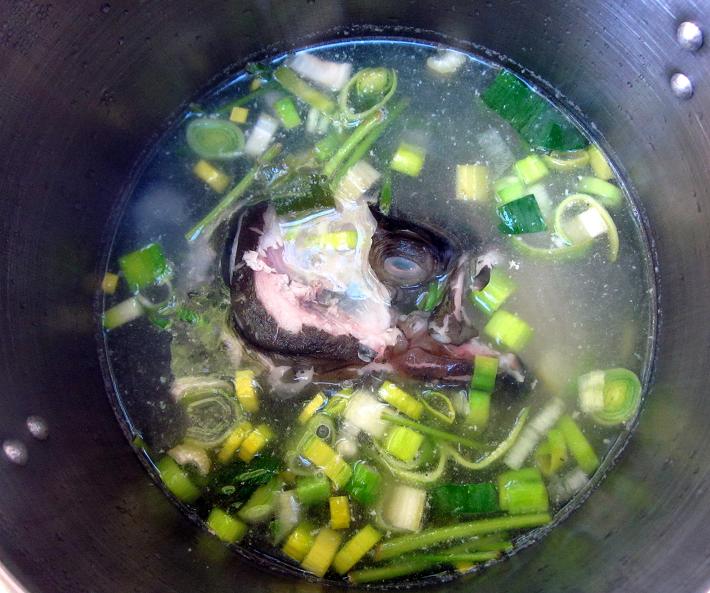
The Kraken Rises! - Set up a ladle and a small bowl filled with cold water beside your stockpot. Use the ladle to skim off the protein scum that rises to the surface of your stock, and deposit it into the bowl. The water absorbs the scum and cleanses the ladle. Repeat this process whenever more whitish-grey scum appears on the surface of the stock.
- Strain the stock through a sieve into a large container, and discard all the solids. Taste the stock and adjust seasonings as required, it probably needs some salt. Cool the stock as rapidly as possible using an ice bath, stirring, or just leaving uncovered on your kitchen table until it’s near room temp, then cover and refrigerate.
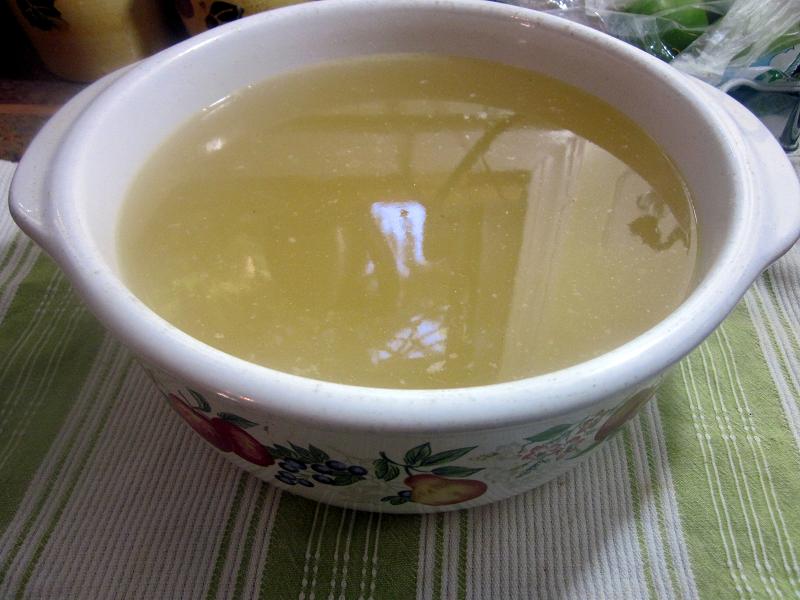
 Music to Cook This To:
Music to Cook This To:
The Thelonious Monk Quartet with John Coltrane Live at Carnegie Hall
For more information on the noble and seriously tasty Halibut, hit up : http://www.iphc.int/
This is a great help. I just got gifted a halibut head 🙂 I am assuming you put the head back in after blanching with the lemon, bay leaves and peppercorns… or did I miss something? Thanks!
Hi Sharon, Thanks for the comment. I’m glad we could help.
You’re right of course! I neglected to mention that the blanched head goes back in the pot during Step 3. I’ve edited the original to make it more clear. Good eyes!
Let us know how your stock turned out.